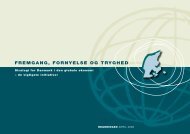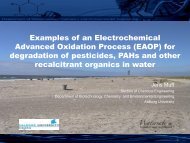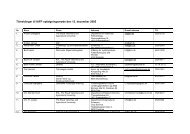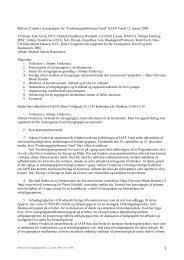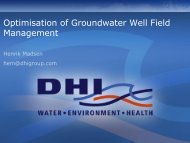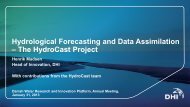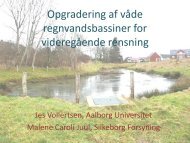INTEGRATED URBAN WATER MANAGEMENT IN BERLIN WITH ...
INTEGRATED URBAN WATER MANAGEMENT IN BERLIN WITH ...
INTEGRATED URBAN WATER MANAGEMENT IN BERLIN WITH ...
You also want an ePaper? Increase the reach of your titles
YUMPU automatically turns print PDFs into web optimized ePapers that Google loves.
<strong><strong>IN</strong>TEGRATED</strong> <strong>URBAN</strong> <strong>WATER</strong> <strong>MANAGEMENT</strong> <strong>IN</strong><br />
BERL<strong>IN</strong> <strong>WITH</strong> FOCUS ON NATURAL <strong>WATER</strong><br />
TREATMENT <strong>IN</strong> A PARTIALLY CLOSED <strong>WATER</strong><br />
CYCLE<br />
Hella Schwarzmüller, Gesche Grützmacher, Regina Gnirss<br />
28.01.2011<br />
for the DWRP11<br />
1
The Berlin Centre of Competence for Water<br />
• Created by Veolia in 1999 during the partial privatisation<br />
of Berliner Wasserbetriebe to promote science, research<br />
and development in the field of water as well as education<br />
• since December 2001 non-profit network societey<br />
2
Main fields of research<br />
3
• Introduction<br />
– The Berlin situation<br />
Outline<br />
• Why a „semi-closed water cycle“?<br />
– Waste water treatment<br />
– Surface water treatment<br />
– Drinking water abstraction<br />
• Special focus: RBF/ MAR<br />
– Quantitative & qualitative aspects<br />
• Future challenges<br />
– Expected changes<br />
– Water treatment options<br />
– Management options<br />
4
• Introduction<br />
– The Berlin situation<br />
Outline<br />
• Why a „semi-closed water cycle“?<br />
– Waste water treatment<br />
– Surface water treatment<br />
– Drinking water abstraction<br />
• Special focus: RBF/ MAR<br />
– Quantitative & qualitative aspects<br />
• Future challenges<br />
– Expected changes<br />
– Water treatment options<br />
– Management options<br />
5
Berlin<br />
Havel<br />
Wannsee<br />
Havel<br />
The Berlin Situation<br />
29...35 m asl<br />
Spree<br />
Teltow -<br />
Plateau<br />
35...50 m asl<br />
6<br />
Barnim -<br />
Plateau<br />
35...65 m asl<br />
~ 40 km<br />
Spree<br />
~ 35 km<br />
Dahme<br />
Müggelsee
• Water supply:<br />
– 202 mio. m³/ year<br />
– 7.857 km distribution networks<br />
– 9 water works<br />
– 953 wells<br />
Facts and figures<br />
7<br />
• Sewer systems:<br />
– 224 mio. m³/ year<br />
– 9.400 km sewers<br />
– 1.127 km pressure pipelines<br />
– 4 WWTP<br />
– 147 pump stations
Precipitation:<br />
- 570 mm/a (15 m³/s)<br />
Average discharge:<br />
- Spree: 25 m³/s<br />
- Havel: 15 m³/s<br />
Natural groundwater recharge:<br />
- 4.8 l/s*km² (4 m³/s)<br />
Drinking water demand:<br />
- 202 mio m³/a (6 m³/s)<br />
Havel<br />
Havel<br />
8<br />
Dahme<br />
Brunnengalerien<br />
Spree
• Introduction<br />
– The Berlin situation<br />
Outline<br />
• Why a „semi-closed water cycle“?<br />
– Waste water treatment<br />
– Surface water treatment<br />
– Drinking water abstraction<br />
• Special focus: RBF/ MAR<br />
– Quantitative & qualitative aspects<br />
• Future challenges<br />
– Expected changes<br />
– Water treatment options<br />
– Management options<br />
9
Water works<br />
Berlin’s Water Cycle<br />
U S E<br />
Surface water<br />
resource<br />
Groundwater<br />
resource<br />
10<br />
Waste water<br />
treatment plant
Waste water treatment<br />
• Conventional activated sludge treatment with N/P removal<br />
and secondary clarification<br />
– N removal: pre-denitrification<br />
– P removal: enhanced biological P-removal or chemical precipitation<br />
• Hydraulic retention times<br />
– biological stage: 15 h<br />
– sludge retention time: 18 d<br />
• Average effluent concentrations<br />
– TSS: 6 mg/L<br />
– TN inorg: 13 mg N/L<br />
– total-P: 0.5 mg P/L<br />
– DOC: 10 – 15 mg/L<br />
– BOD: < 3 mg/L<br />
11
• Non-polar trace organics<br />
– Sorbed onto activated sludge<br />
• Volatile trace organics<br />
– Stripped during aeration<br />
• Other<br />
– Not being removed during<br />
conventional waste water<br />
treatment<br />
– Bio-degradation in surface<br />
waters<br />
– > Subsurface passage?<br />
– > Dilution effects by mixing?<br />
Trace organics removal<br />
12<br />
Location AAA<br />
(μg/L)<br />
Estrone<br />
(ng/L)<br />
Carbamazepine<br />
(μg/L)<br />
Inflow STPs 10-15 60-150 2-5<br />
Effluent STPs 3-9 2-20 2-5<br />
Surface water ( ) 0.4-1.6 0.5-2 0.2-0.9<br />
Bank filtrate (< 1 month travel time) 0.1-0.2
Surface Water quality aspects<br />
• Surface water treatment plants<br />
Lake Tegel:<br />
– Phosphorous removal (-99%)<br />
– Precipitation/ Coagulation/<br />
Flocculation<br />
– Sedimentation<br />
– Post precipitation<br />
– Filtration<br />
13<br />
Oberhavel<br />
Pumpwerk<br />
Oberhavel<br />
Tegeler See<br />
Fläche: 4 km²<br />
Durchschnittliche Tiefe: 6,6 m<br />
Maximale Tiefe: 15 m<br />
Volumen: 24,6 Mio. m³<br />
theoretische Aufenthaltszeit: 3 bis 4 Monate bei 3 m³/s<br />
Überleitung zur OWA<br />
und Rückleitung von<br />
gereinigtem Wasser<br />
Tegeler F ließ<br />
Blankenfelder<br />
Graben<br />
OWA - Tegel<br />
Inbetriebnahme im August 1985<br />
Wasserwerk Tegel<br />
Ableiter vom<br />
Klärwerk<br />
Nordgraben<br />
ehemalige Rieselfelder<br />
Außerbetriebnahme 1986<br />
Klärwerk Schönerlinde<br />
Inbetriebnahme 1986<br />
Verteilbauwerk<br />
Arkenberge<br />
Panke<br />
Buchholzer Graben<br />
Panke<br />
Verteilbauwerk<br />
Blankenburg
Grundwassergewinnung<br />
Drinking water abstraction<br />
• Abstraction by<br />
– ~ 700 vertical filter wells<br />
– 2 radial collector wells<br />
• All situated along lakes / rivers<br />
– Ideal situation for RBF<br />
– Subsurface passage as<br />
main treatment step<br />
14<br />
Abb.: BWB
well<br />
aeration<br />
Drinking water production<br />
Principle of post-treatment in all Berlin waterworks<br />
filtration<br />
15<br />
storage<br />
Fe & Mn removal<br />
no chlorination,<br />
no addition of chemicals<br />
pumping
• Introduction<br />
– The Berlin situation<br />
Outline<br />
• Why a „semi-closed water cycle“?<br />
– Waste water treatment<br />
– Surface water treatment<br />
– Drinking water abstraction<br />
• Special focus: RBF/ MAR<br />
– Quantitative & qualitative aspects<br />
• Future challenges<br />
– Expected changes<br />
– Water treatment options<br />
– Management options<br />
16
Grundwassergewinnung<br />
Groundwater recharge<br />
60 % 30 % 10 %<br />
17<br />
10
Berlin<br />
• Qualitative issues<br />
– Insufficient surface water quality in the 19 th century (without technical<br />
treatment)<br />
� First „groundwater“ production plant at Lake Tegel<br />
• Quantitative issues<br />
– Insufficient natural groundwater recharge<br />
� Wells were drilled close to surface waters to supplement naturally<br />
recharged water with bank filtrate<br />
• Political issues<br />
Why was MAR implemented?<br />
– During the cold war West Berlin needed to maintain an independent<br />
drinking water production<br />
� Installation of infiltration ponds in Tegel and Spandau.<br />
18
Bank filtration & managed aquifer recharge<br />
• Bank filtration<br />
– Supplementing groundwater resources by surface water infiltration<br />
19
• Elimination processes:<br />
filtration<br />
sorption<br />
degradation<br />
precipitation<br />
Water Quality Aspects<br />
mixing<br />
20<br />
ambient groundwater
Bank filtration & Managed aquifer recharge<br />
• Aquifer recharge<br />
– Replenish Groundwater by surface water via infiltration ponds<br />
surface water<br />
Q Q<br />
pond<br />
aquifer<br />
21<br />
unsaturated zone<br />
abstraction<br />
Greskowiak et al. (2007)
Artificial recharge at the Tegel water works<br />
22<br />
Microsieve<br />
Infiltration pond
Artificial recharge at the Spandau water works<br />
„Kuhlake“ Pond operation<br />
23
n = 170 sites<br />
Comparing Berlin to other BF/ AR sites<br />
24
n = 170 sites<br />
Comparing Berlin to other BF/ AR sites<br />
25
Development of Hydrogeological Methods<br />
Transsect at Lake Wannsee<br />
Tracer<br />
lake observation wells<br />
- sewage indicators<br />
(e.g. Gd-DTPA, chloride, EDTA)<br />
- substances with clear seasonality<br />
(e.g. stable isotopes, temperature)<br />
� Travel times:<br />
< 3 months to > 10 years<br />
� Bank filtration share: 30 % to 60 %<br />
26<br />
production well<br />
Picture TUB<br />
~ 40 m
Basis for Process Understanding: Hydrochemistry<br />
Transsect at Lake Wannsee<br />
aerobic<br />
anaerobic<br />
� bank filtrate passes through different redox zones<br />
� different degradation mechanisms can apply<br />
27<br />
Picture TUB
Challenges and research topics<br />
• Hydraulics / Hydrochemistry<br />
– Different permeability of the<br />
banks<br />
– Retarded oxygen depletion due<br />
to low temperatures<br />
– Formation of a clogging layer<br />
28
• Introduction<br />
– The Berlin situation<br />
Outline<br />
• Why a „semi-closed water cycle“?<br />
– Waste water treatment<br />
– Surface water treatment<br />
– Drinking water abstraction<br />
• Special focus: RBF/ MAR<br />
– Quantitative & qualitative aspects<br />
• Future challenges<br />
– Expected changes<br />
– Water treatment options<br />
– Management options<br />
29
• Climate change<br />
Expected changes<br />
– Increase in waste water share due to less summer precipitation<br />
– Extreme weather events leading to combined sewer overflows<br />
– Rising temperatures shifting redox zonation<br />
• Legislation:<br />
– Quality standards for trace organic substances requiring higher<br />
efforts for waste water treatment<br />
• Impact of upstream mining activities<br />
– Flooding of abandoned open-pit mines<br />
– Decreased discharge of the Spree river<br />
– Increased sulfate loads<br />
30
• Drinking water abstraction:<br />
Future challenges<br />
– Does subsurface passage remove relevant waste-water<br />
contaminants, toxins produced by algaea blooms, pathogens?<br />
– Which are the key parameters that define the Berlin BF & AR<br />
system?<br />
– Can future changes (temperature, recharge etc.) impact drinking<br />
water quality?<br />
Research projects of<br />
31
Water treatment options<br />
• Advanced waste water or drinking water treatment:<br />
– Ozonation in combination with subsurface passage<br />
� oxidation of persistent trace organics (e.g. carbamazipine,<br />
sulfamethoxazole)<br />
� possible removal of by-products by subsurface passage<br />
– PAC dosing:<br />
32<br />
Miehe (2010)
Combination of different treatment methods<br />
e.g. with<br />
� Ozonation<br />
� Aeration & rapid filtration (Fe, Mn)<br />
� Activated carbon (trace substances)<br />
� Disinfection (pathogens)<br />
Depending on surface water quality and<br />
hydrogeological framework<br />
33
Management options<br />
• Identification of sources & treatment at the source:<br />
– e.g. treating x-ray contrast media in hospitals<br />
• Management of loads:<br />
– quality controlled water<br />
abstraction<br />
• Life Cycle Assessment:<br />
– Comparison of different<br />
options with respect<br />
to their carbon footprint<br />
KW<br />
34<br />
WW<br />
WW<br />
WW<br />
WW<br />
WW<br />
OWA<br />
WW<br />
KW<br />
KW<br />
KW<br />
KW<br />
WW<br />
WW<br />
WW<br />
12<br />
Bezirke<br />
KW<br />
WW<br />
Mensch<br />
KW<br />
Broll (2005)
Thank you for your attention<br />
• If you want to learn more…<br />
– www.kompetenz-wasser.de<br />
35



